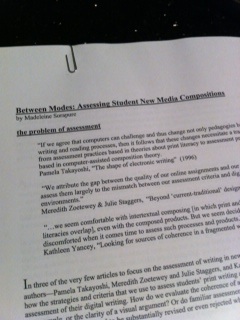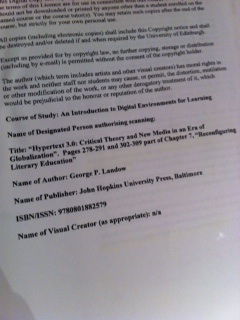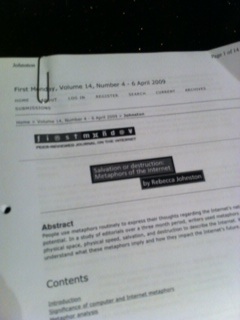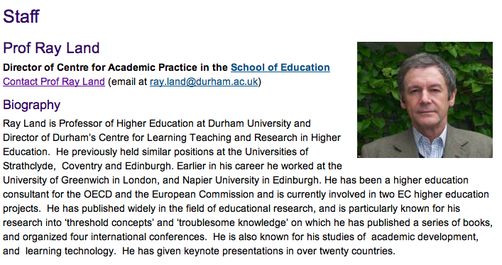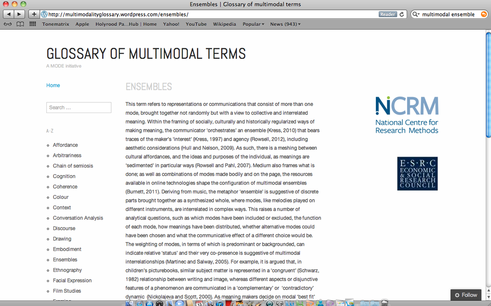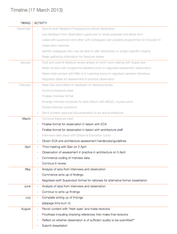|
Having revisited and then categorised the data from the seven interviews, I've rewritten the my original research questions (submitted within my 17 December Research Proposal). On reflection, questions 2 and 3 from my Research Proposal cover too much of the same ground. Also, the questions ignore the conditions that promote/discourage multimodal approaches to assignments, which has been one of more interesting themes to emerge from both the data and my lit review. I think the new combination of questions are also more able to directly address my overarching question posed within the dissertation. Anyway, I have gone... From this:
...to this:
0 Comments
I was tidying up some of the papers from my Lit Review last night and rediscovered these three that I need to revisit when/if time allows. I've snapped them and put the reminder here so I don't overlook them again. A visual reminder.
Following on from my previous post (about McEwan Hall entrance) here's a picture I took of an (old) University crest attached to a wall on Bristo Square. I'm not sure where this will come into my dissertation (if at all) however I'm adding it here as a reminder, and also because I like the photo. Actually, the ideal place for this would be within the Literature review when I'm talking about Ray Land's reflections on university crests. Perhaps I include the static image alongside the text. Or perhaps I develop it in some animated way. Or both.
Jeremy has been kind enough to respond with the requested reading list for the relevant section of the IDEL course, as follows:
All of the names here are familiar and I think I've read most of the resources on the Additional list. The Fitzpatrick however is new to me and was also recommended by Sian at our last meeting, so that's useful.
I'm indebted to Marshall for making me aware of yesterday's Conference. In particular, Ray Land's presentation was directly relevant to my research as it touched on digital scholarship, the history of texts in Western universities, multimodality and other themes. Here are my frantically-typed-at-the-time notes:
I've e-mailed Marshall this evening to see whether I can get a copy of the full slides from his presentation. Meanwhile, I've had a look at Ray Land's profile on the Durham University website and includes his publications list: One of my tasks for this week will be to go back and reflect on some of the themes he touched on and consider how they might inform my lit review or research in general.
I came across this potentially useful resource today: It looks like a nicely prepared document, perhaps even a lit review. I'll come back to this later on.
I've been a bit slow on this. Here are the notes from last week's meeting with Sian where we discussed my second draft lit review, dissemination, data analysis and a few other bits and pieces.
Some general comments:
Gaps, weaknesses and room for improvement:
Fitzpatrick?
Things to leave out:
I've had a quick look at the literature review from Michael's dissertation. The subject matter is entirely different to my own, however I'm interested in style, structure and length.
It will be useful to see how this compares with other literature reviews.
Last Friday afternoon I caught up briefly with Jeremy to get his thoughts on preparing a lit review, based upon his own experience of completing the MSc dissertation. Here are a few of the key points:
Jeremy has since sent me a link to his dissertation, although he notes that his entire dissertation was a lit review i.e. entirely desk bound research based upon the theory. Over lunch I'm reading Carey Jewitt's 'Rethinking Assessment: Multimodality, literacy and computer mediated learning (2003). It's a really good (and relevant) read, even if the focus is upon high school study of a CD-Rom version of John Steinbeck's Of Mice and Men.
Using the celestial metaphor of stars within a constellation. The autor created the all the individual elements of the multimodal assignments. These might be images, sound clips, passages of written text, animation. These are the stars. They are projected onto the canvas by the author. The author intends to demonstrate his understanding or world view through this assesmblage of stars. The reader has a gazes upon the different stars glistening on the black canvas overhead. She then follows her own path between the different stars, studying one element, then another and then another. She follows her own path between the stars. She might return to a star of pariticular interest. She might do this more than once for, having seen subsequent stars the first star might make more sense. She is making sense of the relationship between the elements. She tries to make sense of the the elements by making sense of the combined knowledge they project. She is intepreting meaning from the assemblage of image, text and sound. She attaches meaning to this constellation based upon the unique journey she followed between them. The reader/astronomer has followed her own path, not a trajectory proposed by the author. She is not receiving the message transmitted by the stars (author), she is constructing meaning upon what has been projected onto the sky canvas. As such she is a producer - she is constructing information. She negotiates this meaning with the author. |
Categories
All
Archives
October 2013
TimelineOther stuff
|
||||||||||||||
